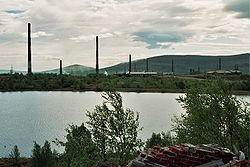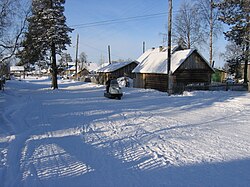Murmansk Oblast
Murmansk Oblast (Russian: Му́рманская о́бласть, Murmanskaya oblast' ) is a federal subject in northwestern Russia. The administrative centre is Murmansk, where most of the population lives. The oblast has a population of 741,511.
History
Records show people first began to populate the area sometime between 8000 BC and 7000 BC.[1][2] The first permanent towns began to appear in the 15th century. These towns were mainly on the Tersky Coast. In the late 15th century, the area became part of the Grand Duchy of Moscow. At the time, most of the economy was based on fishing.
Oblast divisions
The oblast is divided into six districts, six closed cities and six cities and towns under the oblast's control.
Districts
The six districts are: Kandalakshsky District, Kolsky District, Kovdorsky District, Lovozersky District, Pechengsky District, Tersky District.
Closed cities
The six closed cities are: Gadzhiyevo, Ostrovnoy, Polyarny, Severomorsk, Snezhnogorsk and Zaozyorsk.
These cities are controlled by the federal government. A "closed city" is a term for a city where residents need special permission to live there.
Cities and towns under the oblast's control
The six cities and towns under the oblast's control are: Murmansk, Apatity, Kirovsk, Monchegorsk, Olenegorsk and Polyarnye Zori.
These cities have their own oblast territory.
Climate
Most of the oblast is in the arctic circle, meaning in summer the sun is in the sky all day, while at night the sun never rises. The entire oblast also has a subarctic climate, with very cold winters, and short, warm summers. The area isn't as cold as other locations of the same longitude because of the effects of the North Atlantic Current. The current's influence also means that the northern coast is generally "warmer" than the southern central region.
Demographics
The native people of the area are the Sámi, but they only make up 0.2% of the population today.
Below is a list of the largest cities in the oblast:
| Rank | City | Population (2019) | Coordinates |
|---|---|---|---|
| 1 | Murmansk | 292,465 | 68°57′31″N 33°4′58″E / 68.95861°N 33.08278°E |
| 2 | Apatity | 55,201 | 67°34′40″N 33°23′26″E / 67.57778°N 33.39056°E |
| 3 | Severomorsk | 52,597 | 69°3′56″N 33°24′33″E / 69.06556°N 33.40917°E |
| 4 | Monchegorsk | 41,482 | 67°56′35″N 32°53′31″E / 67.94306°N 32.89194°E |
| 5 | Kandalaksha | 30,575 | 67°10′12″N 32°25′23″E / 67.17000°N 32.42306°E |
| 6 | Kirovsk | 26,206 | 67°36′39″N 33°40′21″E / 67.61083°N 33.67250°E |
| 7 | Olenegorsk | 20,697 | 68°8′33″N 33°15′27″E / 68.14250°N 33.25750°E |
| 8 | Polyarny | 17,605 | 69°11′55″N 33°26′22″E / 69.19861°N 33.43944°E |
| 9 | Kovdor | 16,435 | 67°34′12″N 30°28′26″E / 67.57000°N 30.47389°E |
| 10 | Zapolyarny | 14,902 | 69°25′29″N 30°49′24″E / 69.42472°N 30.82333°E |
Approximately 42% of the population adhere to the Russian Orthodox Church. Another 4.5% follow another form of Christianity. 1% of the population is Muslim, 12% are atheists and 28% are "spiritual but not religious."[3][4]
Murmansk Oblast Media
Vaidagubsky lighthouse in Murmansk Oblast
The Polar Alpine Botanical Garden (Полярно-альпийский ботанический сад-институт) in Kirovsk
A Norilsk Nickel plant (formerly, Severonikel) in Monchegorsk
In Krasnoshchelye, a village on the Ponoy River
References
- ↑ В. Я. Шумкин. Этапы освоения Северо-Запада Европейской Арктики, 2015
- ↑ http://kae.rekvizit.ru/olen/olintr.htm Archived 2017-02-12 at the Wayback Machine Кольская археологическая экспедиция
- ↑ Arena - Atlas of Religions and Nationalities in Russia. Sreda.org
- ↑ 2012 Survey Maps Archived 2017-03-20 at the Wayback Machine. "Ogonek", № 34 (5243), 27/08/2012. Retrieved 24-09-2012.
Other websites
- Official website of Murmansk Oblast Archived 2020-11-27 at the Wayback Machine (in Russian)
- Murmansk Oblast news Archived 2017-10-04 at the Wayback Machine







